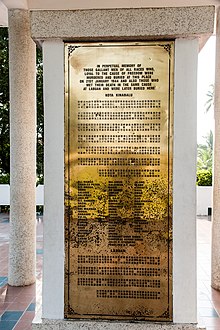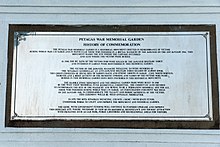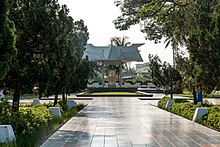Jesselton revolt
| Jesselton revolt | |||||||
|---|---|---|---|---|---|---|---|
 Some names of resistance movement members aside from the main group who were subsequently executed after the revolt. | |||||||
| |||||||
| Belligerents | |||||||
| Kinabalu Guerrillas Defence Forces |
•Occupied British Borneo | ||||||
| Commanders and leaders | |||||||
|
|
| ||||||
| Units involved | |||||||
|
Limited arms support: |
•Kenpeitai | ||||||
| Strength | |||||||
|
100Chinese ≈200Bornean/Philippine indigenous peoples[note 1]/Eurasian/Sikh Indian |
≈Hundreds Japanese police (1943) ≈Thousands Japanese troops (post 1943) | ||||||
| Casualties and losses | |||||||
| 324 resistance members killed | 50–90 police/soldiers killed[note 2] | ||||||
| 2,000–4,000 civilians massacred by the Japanese | |||||||
TheJesselton revolt(also known as theJesselton uprisingor theDouble Tenth Revolt/Incident) was a revolt by aresistance movementknown as theKinabalu Guerrillas,comprising localChinese,indigenous peoples,Eurasian andSikh IndianofJesselton,North Borneoand led byAlbert Kwok,against theJapanese occupying forces of North Borneo.
The movement succeeded in killing around 50–90 Japanese police and soldiers and temporarily took control ofJesselton(which after the war in 1946 would become theNorth Borneoand then laterSabahcapital) and several neighbouring districts ofTuaranandKota Belud.Owing to extremely limited arms supplies, however, the movement was forced to retreat to its hide-out. The JapaneseKenpeitaithen launched attacks against coastal settlements in western North Borneo to find the leader and members of the guerrilla force, with many innocent civilians suffering the various atrocities that have become synonymous with Japanese conquest in thePacific War.
The leader of the revolt finally decided to surrender following Japanese threats to execute more civilians if the guerrillas did not turn themselves in. Following the arrest and subsequent execution of the rebel alliance, the Japanese returned to administerNorth Borneountil 1945 when the main Allied liberation mission arrived.
| History ofMalaysia |
|---|
 |
|
|
Background
[edit]
Due to persistently harsh rule under the Japanese occupation, resistance against the Japanese developed, especially on the west coast of North Borneo, where a revolt was led byAlbert Kwokwith the members comprising mostlyChineseand someindigenous peoples.[1][2]Kwok, a localTeochew ChinesefromKuchingin neighbouringSarawak,had previously been working with theChina Red Crossand serving under theKuomintangofChiang Kai-shek,[3][4]before returning to Borneo throughMalayain 1940.[5][6]During his time in China, Kwok was also a student of theSeventh-day Adventist Mission SchoolinCanton.He arrived in Jesselton on 15 May 1941 and started a medical practice treatingpiles.[4][7]
In February 1942, Kwok wanted to establish contact with the Australians or Americans in eastern North Borneo, but he was unable to continue his trek by foot across the island jungle when he reachedPensiangan,which had a great number of Japanese troops.[3]He needed to establish relations with the Allied movements, especially theUnited States Forces in the Philippines(USFIP), as they were the sole armed resistance movement in the region at the time which had a good supply of firearms.[8]After he managed to establish contact with the American forces in the Philippines with the help of a fellow Chinese businessman namedLim Keng Fatt,[8][9]a Muslim cleric (Imam) namedMarajukimfromSuluwho was part of theresistance movementin thePhilippinesapproached Kwok in Jesselton where he hence departed toTawi-Tawifor training.[10]From there, they travelled further to Sulu and metLieutenant ColonelAlejandro Suarez,learning of resistance movement operations in the Philippine archipelago.[8][11][12]
In May 1943, Kwok returned to Jesselton greatly determined to liberate North Borneo. Upon arrival, he first contacted theOverseas Chinese Defence Association(OCDA), with whose help he acquired medical equipment and cash donations for the support of the resistance in Sulu.[13]Once again, in June 1943, he travelled with Marajukim to the Philippines. Through the mediation of Suarez, he met with the representatives of theUS armyand was commissioned as a Lieutenant on 1 July 1943.[14]Upon his second return to North Borneo, Kwok arrived with three pistols, a box of handgrenades,and a promise to be given more weapons.[15]However, in the end, he could not induce the guerrillas in theSulu Archipelagoto send more firearms, and he was forced to launch a revolt with limited supplies.[16]A resistance group under his leadership was then established on 21 September 1943, with the group calling themselves theChinese National Salvation Association(CNSA),[17]a branch of the OCDA.[16]With collaboration between the Chinese and indigenous peoples, the group was subsequently known asKinabalu Guerrillas Defence Force.[11][18]
Uprising
[edit]
As the date of execution for a pending Japanese decree to seize any in opposition to the Japanese administration loomed closer, the resistance group was forced to launch their revolt ahead of schedule. With many of his members armed with onlymelee weaponssuch asparang,spearandkris,[19]the movement launched their attack from 9 October 1943 and temporarily retook Jesselton,Tuaran,andKota Beludfrom the Japanese, leaving around 50–90 casualties on the Japanese side.[20][21][22]
In the combined land and sea attack on the Japanese, most inhabitants of the islands around the coastal areas contributed ships to the movement. NativeBajau-Sulukleaders such asPanglima Ali(Sulug Island),Jemalul(Mantanani Islands),Orang Tua Arshad(Udar Island), andSaruddin(Dinawan Island) contributed to the revolt mostly through attacks from the sea.[23]Both Jemalul and Saruddin volunteered themselves from the Philippines to lead theBinadansofMantananiand theDinawan Islands.[24]
From land, the revolt was supported by nativeDusun-Murutleaders such asMusahoriginated from Kampong Narupot Bingkor representing theDusunofGanacommunity andDuallisfor theMurut,as well as members of theIndian Imperial Policeled by ConstableSubedar Dewa Singh,[23]and administration and police members of the former colonial authorities of North Borneo, mostly serving under the aegis of theNorth Borneo Volunteer Force(NBVF) led byJules StephensandCharles Peter,[23]as well asSergeantBud SinghandCorporalSohan Singh.[25]
After the successful revolt, the resistance movement under OCDA and NBVF jointly hoisted theflag of the Republic of ChinaandUnion Jackon 10 October 1943.[8]Most of the members of the OCDA were loyal to theRepublic of Chinawhile the NBVF remained loyal to theUnited Kingdom,although the NBVF was not even recognised by the British government.[8]
With Imperial Japanese reinforcements fromKuchingen route to suppress the rebellion, however, Kwok along with other members of the resistance were forced to retreat to their hide-out. The OCDA celebrated the birthday ofSun Yat-sen,the founder of Kuomintang and subsequently the Republic of China, by hoisting the national flag again and singing thenational anthem of the Republic of Chinaon 12 November 1943.[8]
Aftermath and legacy
[edit]
Following the arrival of Japanese reinforcements, the Japanese authorities subsequently launched a ruthless counter-offensive by bombing coastal settlements fromKota BeludtoMembakutand by machine-gunning the North Borneo population.[22][26]Almost every village in the area was burnt down, with around 2,000–4,000 innocent civilians executed— mostly belonging to theBajauandSulukcivilian population.[27][28]After threatening to kill more civilians if the leaders of the uprising did not turn themselves in, Kwok finally surrendered under duress, along with several of his top officers. In all, Kwok and some 175 people who for the most part had nothing to do with the uprising were executed by the Japanese on 21 January 1944 in Petagas,Putatan.[17]
After the war, theInternational Military Tribunal for the Far East(IMTFE) set up in 1946 to prosecute the manyJapanese war crimesconcluded that during theresistance movementled by the Chinese and indigenous peoples in North Borneo, theKenpeitaihad been involved in a reign of terror, arresting, torturing, and massacring hundreds of Chinese rebels while systematically exterminating the coastal population ofSulukpeople.[29][30]The sacrifice of the movement was honoured with a memorial in Petagas, thePetagas War Memorial,today just east of theKota Kinabalu International Airport.
Notes
[edit]Footnotes
[edit]- ^Tarling 2001,p. 196.
- ^Ham 2013,p. 166.
- ^abTregonning 1960,p. 88.
- ^abDanny 1998,p. 154.
- ^Goodwin 1953,p. 31.
- ^Evans 1990,p. 50.
- ^Julitta 2005,p. 312.
- ^abcdefKratoska 2013,p. 124.
- ^Reece 1998,p. 162.
- ^Julitta 2005,p. 318.
- ^abEvans 1990,p. 52.
- ^Dick 1983,p. 55.
- ^Evans 1990,p. 51.
- ^Julitta 2005,p. 328.
- ^Kratoska 2013,p. 125.
- ^abTregonning 1960,p. 89.
- ^abDanny 2004,p. 116.
- ^Kratoska 2013,p. 128.
- ^Abbas & Bali 1985,p. 159.
- ^Kratoska 2013,p. 111.
- ^Luping, Chin & Dingley 1978,p. 40.
- ^abOoi 1999,p. 56.
- ^abcOoi 2010,p. 164.
- ^Dick 1983,p. 47.
- ^Hwang 2010.
- ^Ooi 2010,p. 186.
- ^Ooi 2013,p. 77.
- ^Kratoska 2013,p. 113.
- ^Watt 1985,p. 210.
- ^Thurman & Sherman 2001,p. 123.
References
[edit]- Goodwin, J. W. (1953).Eastern World.Far Eastern.
- Tregonning, K. G. (1960).North Borneo.H.M. Stationery Office.
- Luping, Margaret; Chin, Wen; Dingley, E. Richard (1978).Kinabalu, Summit of Borneo.Sabah Society.
- Dick, Crofton Horton (1983).Ring of Fire: Australian guerrilla operations against the Japanese in World War II.Secker & Warburg.ISBN978-0-436-20157-8.
- Watt, Donald Cameron (1985).The Tokyo War Crimes Trial: Index and Guide.International Military Tribunal for the Far East. Garland.ISBN978-0-8240-4774-0.
- Abbas, Ismail; Bali, K. (1985).Peristiwa-peristiwa berdarah di Sabah(in Malay).Institute of Language and Literature,Ministry of Education (Malaysia).
- Evans, Stephen R. (1990).Sabah (North Borneo): Under the Rising Sun Government.Tropical Press.
- Reece, Bob (1998).Masa Jepun: Sarawak Under the Japanese, 1941-1945.Sarawak Literary Society.ISBN978-983-9115-06-2.
- Danny, Wong Tze-Ken (1998).The Transformation of an Immigrant Society: A Study of the Chinese of Sabah.Asean Academic.ISBN978-1-901919-16-5.
- Ooi, Keat Gin (1999).Rising Sun over Borneo: The Japanese Occupation of Sarawak, 1941–1945.Palgrave Macmillan.ISBN978-1-349-27300-3.
- Thurman, Malcolm Joseph; Sherman, Christine (2001).War Crimes: Japan's World War II Atrocities.Turner Publishing Company.ISBN978-1-56311-728-2.
- Tarling, Nicholas (2001).A Sudden Rampage: The Japanese Occupation of Southeast Asia, 1941-1945.C. Hurst & Co. Publishers.ISBN978-1-85065-584-8.
- Danny, Wong Tze-Ken (2004).Historical Sabah: The Chinese.Natural History Publications (Borneo).ISBN978-983-812-104-0.
- Julitta, Shau Hua Lim (2005).Pussy's in the Well: Japanese Occupation of Sarawak, 1941-1945.Research and Resource Centre, SUPP Headquarters.ISBN978-983-41998-2-1.
- Hwang, Andrew (2010)."Remember the North Borneo resistance fighters".The Star.Archived fromthe originalon 24 October 2017.
- Ooi, Keat Gin (2010).The Japanese Occupation of Borneo, 1941-1945(PDF).Routledge.ISBN978-0-203-85054-1.Archived fromthe original(PDF)on 25 October 2017.
- Ooi, Keat Gin (2013).Post-war Borneo, 1945-50: Nationalism, Empire and State-Building.Routledge.ISBN978-1-134-05803-7.
- Ham, Paul (2013).Sandakan.Transworld.ISBN978-1-4481-2626-2.
- Kratoska, Paul H. (2013).Southeast Asian Minorities in the Wartime Japanese Empire.Routledge.ISBN978-1-136-12514-0.
Further reading
[edit]- Maxwell, J. Hall (1965).Kinabalu Guerrillas: An Account of the Double Tenth 1934 [i.e. 1943].Borneo Literature Bureau.
- Brooks, Ronald J. (1995).Under Five Flags.Pentland Press.ISBN978-1-85821-322-4.
- Danny, Wong Tze-Ken (2006)."The Kinabalu Guerrillas in Local and National History"(PDF).Sabah Society Journal.Department of History, Faculty of Arts and Social Sciences,University of Malaya.pp. 19–30. Archived fromthe original(PDF)on 24 October 2017.
- Danny, Wong Tze-Ken (2007). "The Petagas War Memorial and the Creation of a Heroic Past in Sabah".Journal of the Malaysian Branch of the Royal Asiatic Society.80(2 (293)): 19–32.JSTOR41493694.
- Daily Express (2013)."Granddaughter seeks apology for massacre".Daily Express.Archived fromthe originalon 18 October 2017.
- Lajiun, Jenne (2015)."Relatives share stories of Sabah fallen heroes".The Borneo Post.
- Daily Express (2015)."Albert Kwok's daring raid".Daily Express. Archived fromthe originalon 24 October 2017.
- Daily Express (2017)."82-year-old recalls execution of hero dad in Petagas".Daily Express. Archived fromthe originalon 28 October 2017.
- Ralon, Larry (2019)."Man recalls how father, brother perished in war".Daily Express. Archived fromthe originalon 22 January 2019.
- Conflicts in 1943
- Conflicts in 1944
- History of Sabah
- Japan–Malaysia relations
- Kota Kinabalu
- Massacres in Malaysia
- Massacres in 1944
- Military history of Japan during World War II
- Military history of Malaysia
- South-East Asian theatre of World War II
- South West Pacific theatre of World War II
- World War II prisoner of war massacres by Imperial Japan
- World War II resistance movements
- Japanese war crimes in British Borneo


